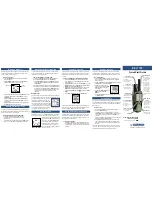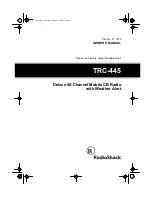
You have two authentication options.
• Open System:
No authentication is imposed to the radio. However, if the 802.1x
option is configured, authentication of connections can be
performed by a RADIUS server.
• Shared: this is for shared key authentication. Data is encrypted.
You have two authentication options.
• Open System:
No authentication is imposed to the radio. However, if the 802.1x
option is configured, authentication of connections can be
performed by a RADIUS server.
• Shared: this is for shared key authentication. Data is encrypted.
WEP enabled, you can manually enter the four data encryption
keys or enable Passphrase to generate the keys automatically.
These values must be matched between all Clients and access
points at your LAN (key 1 must be the same for all, key 2 must be
the same for all, etc.)
Two ways to create WEP encryption keys:
• Passphrase.
Passphrase functions as automatically case-sensitive characters.
However, not all wireless adapters support passphrase key
generation.
• Manual. These values are not case sensitive. 64-bit WEP: enter
10 hexadecimal digits (any combination of 0-9, a-f, or A-F). 128-bit
WEP: enter 26 hexadecimal digits (any combination of 0-9, a-f, or
A-F). 152-bit WEP: enter 32 hexadecimal digits (any combination of
0-9, a-f, or A-F).
WEP enabled, you can manually enter the four data encryption
keys or enable Passphrase to generate the keys automatically.
These values must be matched between all Clients and access
points at your LAN (key 1 must be the same for all, key 2 must be
the same for all, etc.)
Two ways to create WEP encryption keys:
• Passphrase.
Passphrase functions as automatically case-sensitive characters.
However, not all wireless adapters support passphrase key
generation.
• Manual. These values are not case sensitive. 64-bit WEP: enter
10 hexadecimal digits (any combination of 0-9, a-f, or A-F). 128-bit
WEP: enter 26 hexadecimal digits (any combination of 0-9, a-f, or
A-F). 152-bit WEP: enter 32 hexadecimal digits (any combination of
0-9, a-f, or A-F).
Security Encryption
(WEP) Keys
Security Encryption
(WEP) Keys
Network
Authentication
Network
Authentication
5-3 Understanding WEP/WPASecurity Options
The following elaborate WEP/WPA security options.
Field
Description
Encryption Strength
You can select the following data encryption options: Disabled
64- 128- or 152-bit WEP With Open System Authentication and 64-
128- or 152-bit WEP Data Encryption with Shared Key
authentication
You can select the following data encryption options: Disabled
64- 128- or 152-bit WEP With Open System Authentication and 64-
128- or 152-bit WEP Data Encryption with Shared Key
authentication
WPA Pre-Shared-Key uses a pre-shared key to perform the
authentication and generate the initial data encryption keys. Then, it
dynamically varies the encryption key. It uses Temporal Key
Integrity Protocol (TKIP) for encryption keys. However not all
wireless adapters support WPA. Furthermore, client software is
required on the client. Windows XP and Windows 2000 with Service
Pack 3 do include the client software that supports WPA.
Nevertheless, the wireless adapter hardware and driver must also
WPA Pre-Shared-Key uses a pre-shared key to perform the
authentication and generate the initial data encryption keys. Then, it
dynamically varies the encryption key. It uses Temporal Key
Integrity Protocol (TKIP) for encryption keys. However not all
wireless adapters support WPA. Furthermore, client software is
required on the client. Windows XP and Windows 2000 with Service
Pack 3 do include the client software that supports WPA.
Nevertheless, the wireless adapter hardware and driver must also
WPA-PSK (Wi-Fi
Protected Access
Pre-Shared Key)
WPA-PSK (Wi-Fi
Protected Access
Pre-Shared Key)
www.lanpro.com
















































